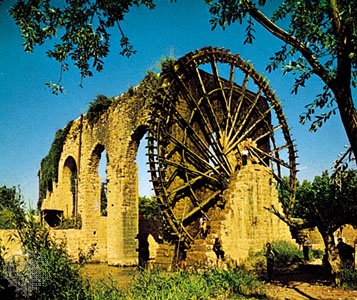Ḥamāh
Syria
also spelled Hama,
 city, central Syria, on the banks of the Orontes River. It was an important prehistoric settlement, becoming the kingdom of Hamath under the Aramaeans in the 11th century BC. It fell under Assyrian control in the 9th century BC, later passing under Persian, Macedonian, and Seleucid rule, the Seleucids renaming the city Epiphaneia in the 2nd century BC. During Byzantine rule it reverted to Emath, a form of its traditional name. When the Arabs took the city in the 7th century AD, they transformed the principal Christian church into a great mosque. Ḥamāh was captured by the crusaders in 1108, retaken by the Muslims in 1115, destroyed by an earthquake in 1175, and occupied by Saladin in 1188, the Egyptian Mamlūk sultans about 1300, and the Ottomans in the early 16th century. It passed to modern Syria after World War I.
city, central Syria, on the banks of the Orontes River. It was an important prehistoric settlement, becoming the kingdom of Hamath under the Aramaeans in the 11th century BC. It fell under Assyrian control in the 9th century BC, later passing under Persian, Macedonian, and Seleucid rule, the Seleucids renaming the city Epiphaneia in the 2nd century BC. During Byzantine rule it reverted to Emath, a form of its traditional name. When the Arabs took the city in the 7th century AD, they transformed the principal Christian church into a great mosque. Ḥamāh was captured by the crusaders in 1108, retaken by the Muslims in 1115, destroyed by an earthquake in 1175, and occupied by Saladin in 1188, the Egyptian Mamlūk sultans about 1300, and the Ottomans in the early 16th century. It passed to modern Syria after World War I.Ḥamāh serves as an important agricultural market centre for cotton, cereals, fruit, and vegetables. Other economic activities include flour milling, wool and textile weaving, tanning, and cement manufacturing. Especially famous are the city's gardens, which flank the river and are irrigated by great wooden waterwheels (waterwheel) (Arabic: nāʿūra) measuring between 33 feet (10 metres) and 72 feet (22 metres) in diameter. They were constructed in the 14th century to raise water to aqueducts, which supplied water for drinking and irrigation. Several of the original 32 of these waterwheels are in present-day use.
The Bayt ʿAẓm palace, originally the residence of the Wali of Hama, was restored by the Syrian Department of Antiquities but was damaged in fighting in 1982. A perfectly preserved 18th-century Arab house, it is now a museum housing artifacts from the citadel of Hama, a little to the north of the city. This citadel (or tell) has produced artifacts from the 5th millennium BC down through the Syro-Hittite kingdom of Hamath in the 2nd millennium into the Byzantine period. In the early 1980s increasing political unrest culminated in a rebellion in the city by the Muslim Brotherhood in February 1982. The uprising was suppressed by the Syrian government with great force; about one-fourth of the old city was destroyed, and some 25,000 people were estimated to have been killed. Pop. (2004 est.) 366,800.
- Chilean cedar
- Chile earthquake of 1960
- Chile, flag of
- Chile lantern tree
- Chilembwe, John
- Chile Rise
- Chile saltpetre
- Chililabombwe
- chili pepper
- Chilka Lake
- Chilkat weaving
- chillawong
- Chillicothe
- Chillida, Eduardo
- Chilliwack
- Chillán
- Chiloé Island
- Chilpancingo
- Chilpancingo, Congress of
- Chilperic I
- Chilperic II
- Chiltern
- Chiltern Hills
- Chi-lung
- Chilwa, Lake